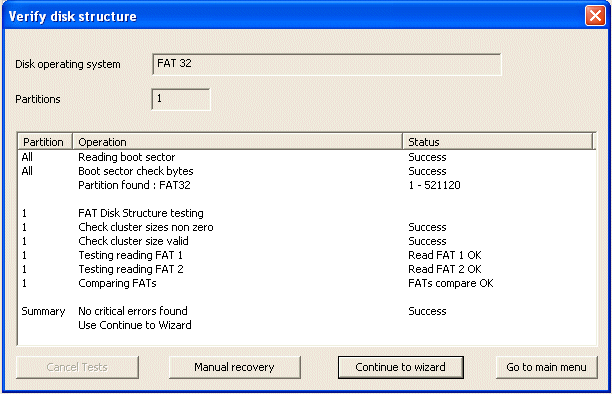|
Verify disk structure
|   |
The verify disk structure is a series of tests to see if the most important parts of the disk are correct and valid. If the tests are successful, then the Wizard will probably recover the required files. If the tests fail, then the program will recommend a more hands on approach to recovery using the manual tools. The type of tests carried out are based on what an experienced data recovery person would do to determine the status of a disk before attempting and further recovery.

The tests are dependant on the disk operating system, and will automatically sequence through for all detected operating systems. Thus some disks have a mixture of FAT and NTFS.
Each test will be described briefly, and a status given.
There are a different series of test for each type of media. For CDs, various areas of the disk are examined and for a blank CD-RW, it will suggest that an unerase process could be tried.
The tests are done for all partitions, and so the partition being tested is shown in the first column. Details of each test are described below.
Boot sector tests
For any disk to read logically it must have a valid boot sector. This is therefore the first test of any data recovery routine. The sector must be readable, and contain valid data. For instance, the check bytes test (see in the picture above) ensures that the final two bytes of the boot sector do contain the bytes 0x55 and 0xAA. It will then decode the 1 to 4 partition tables stored at location 0x1be in the boot sector.
If the boot sector has failed, then the program will indicate that the partitions function should be called to reconstruct a partition table.
CD and DVD tests
Many CDs and DVDs fail due to not being to read the start of the disk. The tests performed are to determine how much of the start of the CD/DVD can be read physically. For video mini-DVDs, it is common for the start to be blank, and then video to be found at about sector 0x4000.
FAT Tests
A FAT disk is read using information such as cluster size, and FAT tables. This information is read from the control sector at the start of the FAT partition. Simple tests are carried out here to make sure that the parameters are within sensible ranges. For instance, a cluster size must always be a multiple of sectors, such as 1, 2, 4, 8. If a cluster size of 3 or 17 is found, this is invalid. The disk analysis routine in the FAT handler will assist in resolving this problem, but the straight forward wizard will not work.
It is also important that the FAT sectors can be read. The test will attempt to read both blocks of FAT sectors. Each block should be identical, so it also compares them. Any errors detected will indicate problems with the disk. These may be overcome by reading the disk, ignoring the FAT, or reading the disk and using FAT2. When reading the disk, the FAT handler, when it finds a failed sector in FAT 1 will automatically look at FAT 2 to see if the matching sector can be read.
NTFS tests
The most important part of a NTFS disk is the $MFT file. This stores all file entry details. The verify routine does a simple physical read of this file, and a verification of the first MFT entry.
At the end of the tests there will be a suggestion as to the next stage. Typically it will be Continue to Wizard. Other options can be Manual Recovery, or Go to main menu.
Manual Recovery will exit the wizard and select the Recover Function. At this stage one will have an indication of possible problems with the disk, as well as areas that are considered to be valid
Go to main menu will exit the wizard and go to the main program menu - no further assistant prompts will be given.